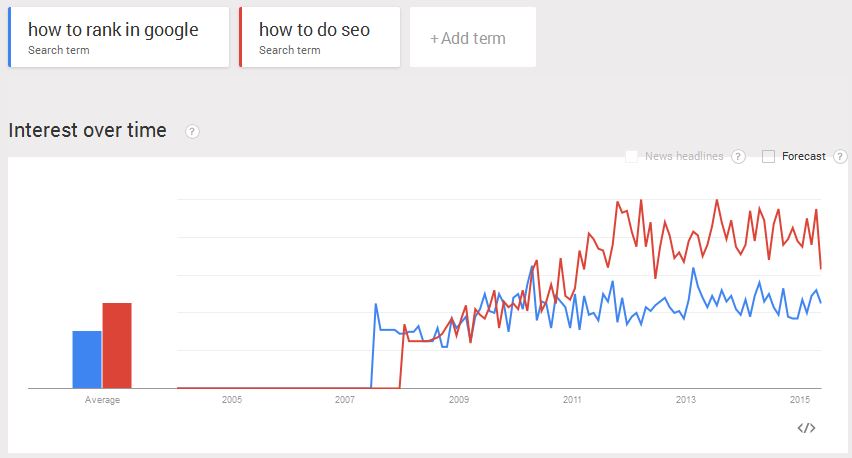This is perhaps a question that precedes all implicit purposes of why you’re doing SEO – whether you’re an agency doing it for a client, you’re a freelancer working on your own site or you’re a small business owner trying SEO out for the first time. It is a timeless question that deserves an answer.
And yes there are ways to know.
How to Tell your SEO is Working
Quick Answer: If you’re moving in the search results for your targeted keywords, that is a good sign your SEO efforts are paying off. Other indicators are:
- Your website is gaining more organic traffic.
- Your conversion rate is improving.
- Visitors are looking through your website more often.
- More websites are linking to yours.
- Website speed and health is better than before.
- You’re organically ranking for related keywords.
Fluctuation Factors
How to know if your SEO is really working is not an easy thing to find out – especially with all the factors at play. So I’ll break it down to major fluctuation factors. Most of which are out of your direct control:
- Website Changes
- Google Changes
- Competition
- Searcher Behavior Changes
Keep these four things in mind for now.
Basically, there are two main things that you should use to make sure your SEO is working and these are your Keyword Rankings and Traffic.
1) Keyword Rankings
This is why rank tracking is important and is a big industry today. Knowing where your keywords are in the search results is the main indicator of your SEO efforts. Without movement, even if your website is new, means that you’re not doing SEO right at all.
If there are some fluctuations in the first three months in your keyword rankings, that’s a good thing. It generally means your SEO efforts are starting to take effect. The goal is that at the 6th month, you’re at the first page of the search results for your target keywords.
This is also why a rank tracker that is in the cloud is especially helpful in keeping tabs on your target keywords and where they are in the search results. We use SERanking in our team and it works perfectly and (more importantly) accurately for us.
2) Traffic
A direct consequence of your keyword rankings is your traffic. Gaining traction on keywords with high competition should mean an additional inflow of traffic. Without an increase in traffic, your SEO efforts are, to put it bluntly, useless.
Traffic increase depends on the website’s niche. We’ve ranked websites that have seen an increase in traffic of over 6,500% in a span of a few years to websites that gained only a menial 300% in the same time period. Whatever the increase in traffic is, what’s more important in the end-game is the revenue it brings in.
Let’s try to see these two things in light of the 4 major fluctuation factors, shall we?
Website Changes
These are things that you directly affect. Your site speed through caching, CDN, asynchronous loading of scripts, etc. Your theme’s framework, your structured data markups, your meta tags, and so on and so forth. Things that you could optimize to the fullest extent to positively impact your SEO and your keyword rankings.
Here’s a shortlist for you to know how you could best improve your on site SEO factors:
Headings Tag
Robots.txt
CDN (Self-hosted CDN or Cloud – we use MaxCDN)
Asynchronous or Deferred Loading of Scripts
Microdata / Structured Data Markups
Any and every website change you do – whether it’s a revamp of the design, a back-end change, or what have you – if it affects any of these things, rest assured that it will affect your keyword rankings.
Google Changes
We all know the all-famous updates that Google released as one-two punches against spam. Panda, Penguin, EMD, and the list goes on.
Here’s a list of one of the biggest years of Google changes (2012) from Moz’s Google Algorithm Change History:
2012 Updates
Panda #23 — December 21, 2012
Right before the Christmas holiday, Google rolled out another Panda update. They officially called it a “refresh”, impacting 1.3% of English queries. This was a slightly higher impact than Pandas #21 and #22.
Knowledge Graph Expansion — December 4, 2012
Google added Knowledge Graph functionality to non-English queries, including Spanish, French, German, Portuguese, Japanese, Russian, and Italian. This update was “more than just translation” and added enhanced KG capabilities.
Panda #22 — November 21, 2012
After some mixed signals, Google confirmed the 22nd Panda update, which appears to have been data-only. This came on the heels of a larger, but unnamed update around November 19th.
Panda #21 — November 5, 2012
Google rolled out their 21st Panda update, roughly 5-1/2 weeks after Panda #20. This update was reported to be smaller, officially impacting 1.1% of English queries.
Page Layout #2 — October 9, 2012
Google announced an update to its original page layout algorithm change back in January, which targeted pages with too many ads above the fold. It’s unclear whether this was an algorithm change or a Panda-style data refresh.
Penguin #3 — October 5, 2012
After suggesting the next Penguin update would be major, Google released a minor Penguin data update, impacting “0.3% of queries”. Penguin update numbering was rebooted, similar to Panda – this was the 3rd Penguin release.
August/September 65-Pack — October 4, 2012
Google published their monthly (bi-monthly?) list of search highlights. The 65 updates for August and September included 7-result SERPs, Knowledge Graph expansion, updates to how “page quality” is calculated, and changes to how local results are determined.
Panda #20 — September 27, 2012
Overlapping the EMD update, a fairly major Panda update (algo + data) rolled out, officially affecting 2.4% of queries. As the 3.X series was getting odd, industry sources opted to start naming Panda updates in order (this was the 20th).
Exact-Match Domain (EMD) Update — September 27, 2012
Google announced a change in the way it was handling exact-match domains (EMDs). This led to large-scale devaluation, reducing the presence of EMDs in the MozCast data set by over 10%. Official word is that this change impacted 0.6% of queries (by volume).
Panda 3.9.2 (#19) — September 18, 2012
Google rolled out another Panda refresh, which appears to have been data-only. Ranking flux was moderate but not on par with a large-scale algorithm update.
Panda 3.9.1 (#18) — August 20, 2012
Google rolled out yet another Panda data update, but the impact seemed to be fairly small. Since the Panda 3.0 series ran out of numbers at 3.9, the new update was dubbed 3.9.1.
7-Result SERPs — August 14, 2012
Google made a significant change to the Top 10, limiting it to 7 results for many queries. Our research showed that this change rolled out over a couple of days, finally impacting about 18% of the keywords we tracked.
June/July 86-Pack — August 10, 2012
After a summer hiatus, the June and July Search Quality Highlights were rolled out in one mega-post. Major updates included Panda data and algorithm refreshes, an improved rank-ordering function (?), a ranking boost for “trusted sources”, and changes to site clustering.
DMCA Penalty (“Pirate”) — August 10, 2012
Google announced that they would start penalizing sites with repeat copyright violations, probably via DMCA takedown requests. Timing was stated as “starting next week” (8/13?).
Panda 3.9 (#17) — July 24, 2012
A month after Panda 3.8, Google rolled out a new Panda update. Rankings fluctuated for 5-6 days, although no single day was high enough to stand out. Google claimed ~1% of queries were impacted.
Link Warnings — July 19, 2012
In a repeat of March/April, Google sent out a large number of unnatural link warnings via Google Webmaster Tools. In a complete turn-around, they then announced that these new warnings may not actually represent a serious problem.
Panda 3.8 (#16) — June 25, 2012
Google rolled out another Panda data refresh, but this appeared to be data only (no algorithm changes) and had a much smaller impact than Panda 3.7.
Panda 3.7 (#15) — June 8, 2012
Google rolled out yet another Panda data update, claiming that less than 1% of queries were affect. Ranking fluctuation data suggested that the impact was substantially higher than previous Panda updates (3.5, 3.6).
May 39-Pack — June 7, 2012
Google released their monthly Search Highlights, with 39 updates in May. Major changes included Penguin improvements, better link-scheme detection, changes to title/snippet rewriting, and updates to Google News.
Penguin 1.1 (#2) — May 25, 2012
Google rolled out its first targeted data update after the “Penguin” algorithm update. This confirmed that Penguin data was being processed outside of the main search index, much like Panda data.
Knowledge Graph — May 16, 2012
In a major step toward semantic search, Google started rolling out “Knowledge Graph”, a SERP-integrated display providing supplemental object about certain people, places, and things. Expect to see “knowledge panels” appear on more and more SERPs over time. Also, Danny Sullivan’s favorite Trek is ST:Voyager?!
April 52-Pack — May 4, 2012
Google published details of 52 updates in April, including changes that were tied to the “Penguin” update. Other highlights included a 15% larger “base” index, improved pagination handling, and a number of updates to sitelinks.
Panda 3.6 (#14) — April 27, 2012
Barely a week after Panda 3.5, Google rolled out yet another Panda data update. The implications of this update were unclear, and it seemed that the impact was relatively small.
Penguin — April 24, 2012
After weeks of speculation about an “Over-optimization penalty”, Google finally rolled out the “Webspam Update”, which was soon after dubbed “Penguin.” Penguin adjusted a number of spam factors, including keyword stuffing, and impacted an estimated 3.1% of English queries.
Panda 3.5 (#13) — April 19, 2012
In the middle of a busy week for the algorthim, Google quietly rolled out a Panda data update. A mix of changes made the impact difficult to measure, but this appears to have been a fairly routine update with minimal impact.
Parked Domain Bug — April 16, 2012
After a number of webmasters reported ranking shuffles, Google confirmed that a data error had caused some domains to be mistakenly treated as parked domains (and thereby devalued). This was not an intentional algorithm change.
March 50-Pack — April 3, 2012
Google posted another batch of update highlights, covering 50 changes in March. These included confirmation of Panda 3.4, changes to anchor-text “scoring”, updates to image search, and changes to how queries with local intent are interpreted.
Panda 3.4 (#12) — March 23, 2012
Google announced another Panda update, this time via Twitter as the update was rolling out. Their public statements estimated that Panda 3.4 impacted about 1.6% of search results.
Search Quality Video — March 12, 2012
This wasn’t an algorithm update, but Google published a rare peek into a search quality meeting. For anyone interested in the algorithm, the video provides a lot of context to both Google’s process and their priorities. It’s also a chance to see Amit Singhal in action.
Venice — February 27, 2012
As part of their monthly update, Google mentioned code-name “Venice”. This local update appeared to more aggressively localize organic results and more tightly integrate local search data. The exact roll-out date was unclear.
February 40-Pack (2) — February 27, 2012
Google published a second set of “search quality highlights” at the end of the month, claiming more than 40 changes in February. Notable changes included multiple image-search updates, multiple freshness updates (including phasing out 2 old bits of the algorithm), and a Panda update.
Panda 3.3 (#11) — February 27, 2012
Google rolled out another post-“flux” Panda update, which appeared to be relatively minor. This came just 3 days after the 1-year anniversary of Panda, an unprecedented lifespan for a named update.
February 17-Pack — February 3, 2012
Google released another round of “search quality highlights” (17 in all). Many related to speed, freshness, and spell-checking, but one major announcement was tighter integration of Panda into the main search index.
Ads Above The Fold — January 19, 2012
Google updated their page layout algorithms to devalue sites with too much ad-space above the “fold”. It was previously suspected that a similar factor was in play in Panda. The update had no official name, although it was referenced as “Top Heavy” by some SEOs.
Panda 3.2 (#10) — January 18, 2012
Google confirmed a Panda data update, although suggested that the algorithm hadn’t changed. It was unclear how this fit into the “Panda Flux” scheme of more frequent data updates.
Search + Your World — January 10, 2012
Google announced a radical shift in personalization – aggressively pushing Google+ social data and user profiles into SERPs. Google also added a new, prominent toggle button to shut off personalization.
January 30-Pack — January 5, 2012
Google announced 30 changes over the previous month, including image search landing-page quality detection, more relevant site-links, more rich snippets, and related-query improvements. The line between an “algo update” and a “feature” got a bit more blurred.
If you would try to compare it with 2015’s algorithm changes, the differences are quite stark. There are just 2 changes thus far for this year:
Mobile Update AKA “Mobilegeddon” — April 22, 2015
In a rare move, Google pre-announced an algorithm update, telling us that mobile rankings would differ for mobile-friendly sites starting on April 21st. The impact of this update was, in the short-term, much smaller than expected, and our data showed that algorithm flux peaked on April 22nd.
Unnamed Update — February 4, 2015
Multiple SERP-trackers and many webmasters reported major flux in Google SERPs. Speculation ranged from an e-commerce focused update to a mobile usability update. Google did not officially confirm an update.
These Google-sized fluctuation factors aren’t really easy to deal with if you’re a person who’s website falls out of the best practices and ethical guidelines. And believe me, there are tons of websites out there that have experienced the fierce wrath of Google and was either penalized, or sandboxed out of the main index.
Competition
There are few things you could do with the competition as an SEO specialist. The best thing you could do is really to just study them. If competitors are affecting your rankings (as they naturally would) here are some things you would want to do to check them out:
1) Study their backlink profile – we use Cognitive SEO for this
What you want to achieve: If their backlinks are coming from places where you could also get links from, try and do so. Sometimes they would have links from sites that are low-hanging fruit in terms of getting backlinks from such as dofollow blog comments or forum posts. Sometimes, it would take much more grinding such as guest posts. And sometimes, if you’re extremely lucky, you’ll find a broken link pointing to your competitor and you could steal it outright.
2) Check out what activities users may be doing to spend more time in their site
What you want to achieve: Make your site visitors stay in your site longer than your competitor. We did this in our SEO Hacker Company Services site by embedding an SEO audit tool that visitors can use for free. It takes around 30 seconds for their results to show on our site so they’d have to wait and spend more time there. This is a great way to lower bounce rate and increase user activity and engagement.
Searcher Behavior Changes
Believe it or not, there are times that keywords shift. Take a look at this chart for example:
When the term “SEO” was not yet as popular way back in 2007, people were searching for “How to Rank in Google” much more often. Then SEO got a little bit more mainstream and people started shifting to “How to do SEO”. This is not to say that “How to Rank in Google” searches became fewer. It’s just that “How to do SEO” was the right keyphrase to use and so there is a keyword shift that occurred somewhere in 2011 according to Google Trends.
Of course, seeing this chart as it is now, you’d want to target “How to do SEO” rather than “How to Rank in Google” but way back 2007, “How to do SEO” (almost) didn’t exist as a search phrase. There was a change in searcher behavior and sometimes the new keyword/keyphrase does eat up the previous keyword/keyphrase’s traffic.
So… What did you Learn?
You learned 4 simple things:
1) There are two main things to gauge whether your SEO is working or not
2) There are 4 fluctuation factors that affect those two things
3) You could do something about the fluctuation factors to create a positive impact on your SEO efforts
4) You could use this article to tell your client(s) that SEO is not easy and your stuff is working
Hope this shed some light for you in helping you know if your SEO is working or not. If I missed anything or you think there should be more factors to check than these, please let me know in the comments section below.






